Population Flow Mechanism Study of Beijing-Tianjin-Hebei Urban Agglomeration from Industrial Space Supply Perspective
Abstract
:1. Introduction
2. Materials and Methods
2.1. Study Area
2.2. Data
2.3. Methods
3. Results
3.1. Population Flow
3.1.1. Overall Characteristics and Composition of Population Flow
3.1.2. Flow Mode & Aim
3.1.3. Occupation
3.2. Industry Space Supply
3.2.1. Secondary Industry Space Supply
3.2.2. Tertiary Industry Space Supply
3.3. Fixed Effect Model
4. Discussion
5. Conclusions
Author Contributions
Funding
Institutional Review Board Statement
Informed Consent Statement
Data Availability Statement
Conflicts of Interest
References
- Zhang, W.; Chong, Z.; Li, X.; Nie, G. Spatial patterns and determinant factors of population flow networks in China: Analysis on Tencent Location Big Data. Cities 2020, 99, 102640. [Google Scholar] [CrossRef]
- Halás, M.; Klapka, P.; Tonev, P. The use of migration data to define functional regions: The case of the Czech Republic. Appl. Geogr. 2016, 76, 98–105. [Google Scholar] [CrossRef]
- Jia, J.S.; Lu, X.; Yuan, Y.; Xu, G.; Jia, J.; Christakis, N.A. Population flow drives spatio-temporal distribution of COVID-19 in China. Nature 2020, 582, 389–394. [Google Scholar] [CrossRef]
- Wang, X.; Ding, S.; Cao, W.; Fan, D.; Tang, B. Research on Network Patterns and Influencing Factors of Population Flow and Migration in the Yangtze River Delta Urban Agglomeration, China. Sustainability 2020, 12, 6803. [Google Scholar] [CrossRef]
- Zhang, N.; Huang, H.; Duarte, M.; Zhang, J.J. Dynamic population flow based risk analysis of infectious disease propagation in a metropolis. Environ. Int. 2016, 94, 369–379. [Google Scholar] [CrossRef] [PubMed]
- Acolin, A. Housing trajectories of immigrants and their children in France: Between integration and stratification. Urban Stud. 2018, 56, 2021–2039. [Google Scholar] [CrossRef]
- Zeng, P.; Sun, Z.; Chen, Y.; Qiao, Z.; Cai, L. COVID-19: A Comparative Study of Population Aggregation Patterns in the Central Urban Area of Tianjin, China. Int. J. Environ. Res. Public Health 2021, 18, 2135. [Google Scholar] [CrossRef]
- Zhu, C.; Zhang, X.; Wang, K.; Yuan, S.; Yang, L.; Skitmore, M. Urban–rural construction land transition and its coupling relationship with population flow in China’s urban agglomeration region. Cities 2020, 101, 102701. [Google Scholar] [CrossRef]
- Ravenstein, E.G. The laws of migration. J. Royal Stat. Soc. 1889, 52, 241–305. [Google Scholar] [CrossRef]
- Park, R.E.; Burgess, E.W.; McKenzie, R.D. The City; The University of Chicago Press: Chicago, IL, USA, 1925. [Google Scholar]
- Wirth, L. Urbanism as a Way of Life. Am. J. Sociol. 1938, 44, 1–24. [Google Scholar] [CrossRef]
- Administration, U.; Hoyt, H. The Structure and Growth of Residential Neighborhoods in American Cities. Development 1941, 19, 453–454. [Google Scholar]
- Alonso, W. A theory of the urban land market. Pap. Reg. Sci. 2005, 6, 149–157. [Google Scholar] [CrossRef]
- Lee, E.S. A Theory of Migration. Demography 1966, 3, 47–57. [Google Scholar] [CrossRef]
- Brockheroff, M.P. An Urbanizing World. Popul. Bull. 2000, 55, 3–44. [Google Scholar]
- Herold, M.; Couclelis, H.; Clarke, K. The role of spatial metrics in the analysis and modeling of urban land use change. Comput. Environ. Urban Syst. 2005, 29, 369–399. [Google Scholar] [CrossRef]
- Zipf, G.K. Human Behavior and the Principle of Least Effort; Addison-Wesley: Cambridge, MA, USA, 1949. [Google Scholar]
- Batty, M. Building a science of cities. Cities 2012, 29, S9–S16. [Google Scholar] [CrossRef] [Green Version]
- Gonzalez, M.C.; Hidalgo, C.; Barabasi, A.L. Understanding individual human mobility patterns. Nature 2008, 453, 779–782. [Google Scholar] [CrossRef]
- Brockmann, D.; Hufnagel, L.; Geisel, T. The scaling laws of human travel. Nature 2006, 439, 462–465. [Google Scholar] [CrossRef] [PubMed]
- Simini, F.; Maritan, A.; Néda, Z. Human Mobility in a Continuum Approach. PLoS ONE 2013, 8, e60069. [Google Scholar] [CrossRef]
- Yan, X.-Y.; Wang, W.-X.; Gao, Z.-Y.; Lai, Y.-C. Universal model of individual and population mobility on diverse spatial scales. Nat. Commun. 2017, 8, 1639. [Google Scholar] [CrossRef] [PubMed] [Green Version]
- Rokem, J.; Vaughan, L. Geographies of ethnic segregation in Stockholm: The role of mobility and co-presence in shaping the ‘diverse’ city. Urban Stud. 2018, 56, 2426–2446. [Google Scholar] [CrossRef]
- Křížková, I.; Ouředníček, M. Immigrant internal migration in a new destination country: Do immigrants suburbanise in Czechia and why? Popul. Space Place 2020, 26, e2326. [Google Scholar] [CrossRef]
- Taima, M.; Asami, Y. Determinants and policies of native metropolitan young workers’ migration toward non-metropolitan areas in Japan. Cities 2020, 102, 102733. [Google Scholar] [CrossRef]
- Lityński, P.; Hołuj, A. Macroeconomic Perspective on Urban Sprawl: A Multidimensional Approach in Poland. Land 2021, 10, 116. [Google Scholar] [CrossRef]
- Benessaiah, K. Reconnecting to nature amidst crisis: Harnessing capacities and mobilities for livelihood and land transformations in the Greek back-to-the-land trend. J. Rural. Stud. 2021, 84, 76–89. [Google Scholar] [CrossRef]
- Barrado, V.J.; Suckel, J.L.; Olhabé, B.T.; Cona, F.C. Promoted Urbanization of the Countryside: The Case of Santiago’s Periphery, Chile (1980–2017). Land 2020, 9, 370. [Google Scholar] [CrossRef]
- Crankshaw, O.; Borel-Saladin, J. Causes of urbanisation and counter-urbanisation in Zambia: Natural population increase or migration? Urban Stud. 2019, 56, 2005–2020. [Google Scholar] [CrossRef]
- Karsten, L. Counterurbanisation: Why settled families move out of the city again. Neth. J. Hous. Environ. Res. 2020, 35, 429–442. [Google Scholar] [CrossRef]
- Bosworth, G.; Bat Finke, H. Commercial Counterurbanisation: A driving force in rural economic development. Environ. Plan. A Econ. Space 2019, 52, 654–674. [Google Scholar] [CrossRef]
- Smith, D.P.; Phillips, M.; Culora, A.; Kinton, C. The mobilities and immobilities of rural gentrification: Staying put or moving on? Popul. Space Place 2021, e2496. [Google Scholar]
- Wang, Y.; Wang, F.; Zhang, Y.; Liu, Y. Delineating urbanization “source-sink” regions in China: Evidence from mobile app data. Cities 2019, 86, 167–177. [Google Scholar] [CrossRef]
- He, C.; Chen, T.; Mao, X.; Zhou, Y. Economic transition, urbanization and population redistribution in China. Habitat Int. 2016, 51, 39–47. [Google Scholar] [CrossRef]
- Chen, Z.; Zhang, A.; Shan, X. Urbanization and administrative restructuring: A case study on the wuhan urban agglomeration. Habitat Int. 2016, 55, 46–57. [Google Scholar]
- Song, W.; Liu, M. Assessment of decoupling between rural settlement area and rural population in China. Land Use Policy 2014, 39, 331–341. [Google Scholar] [CrossRef]
- Wang, C.; Liu, Y.; Kong, X.; Li, J. Spatiotemporal decoupling between population and construction land in urban and rural hubei province. Sustainability 2017, 9, 1258. [Google Scholar] [CrossRef] [Green Version]
- Paniagua, A. Urban-rural migration, tourism entrepreneurs and rural restructuring in Spain. Tour. Geogr. 2002, 4, 349–371. [Google Scholar] [CrossRef]
- Mengyu, D.Z.Z.K.Y.; Deng, Z.; Zhang, K.; Yang, M. Problems and Countermeasures of Regional Coordinated Development with Current Characteristics of Migration in China. J. Changsha Univ. 2020, 34, 90–94. [Google Scholar]
- Kates, R.W.; Parris, T.M. Long-term trends and a sustainability transition. Proc. Natl. Acad. Sci. USA 2003, 100, 8062–8067. [Google Scholar] [CrossRef] [Green Version]
- Mitchell, C.J. Making sense of counterurbanization. J. Rural Stud. 2004, 20, 15–34. [Google Scholar] [CrossRef]
- Aner, L.G. Dwelling habitus and urban out-migration in Denmark. Eur. Urban Reg. Stud. 2014, 23, 662–676. [Google Scholar] [CrossRef]
- Jauhiainen, J.S. Will the retiring baby boomers return to rural periphery? J. Rural Stud. 2009, 25, 25–34. [Google Scholar] [CrossRef]
- Siddle, R. People in the Countryside: Studies of Social Change in Rural Britainby Tony Champion; Charles Watkins. Geogr. J. 1992, 158, 337–338. [Google Scholar] [CrossRef]
- Mitchell, C.J.A.; Bryant, C. International Encyclopedia of Human Geography||Counterurbanization; Elsevier: Toronto, ON, Canada, 2009; pp. 319–324. [Google Scholar]
- Bijker, R.A.; Haartsen, T.; Strijker, D. Migration to less-popular rural areas in the Netherlands: Exploring the motivations. J. Rural. Stud. 2012, 28, 490–498. [Google Scholar] [CrossRef]
- Dahms, F.; McComb, J. ‘Counterurbanization’, interaction and functional change in a rural amenity area—A Canadian example-ScienceDirect. J. Rural Stud. 1999, 15, 129–146. [Google Scholar] [CrossRef]
- Song, Y.; Zhang, C. City size and housing purchase intention: Evidence from rural–urban migrants in China. Urban Stud. 2019, 57, 1866–1886. [Google Scholar] [CrossRef]
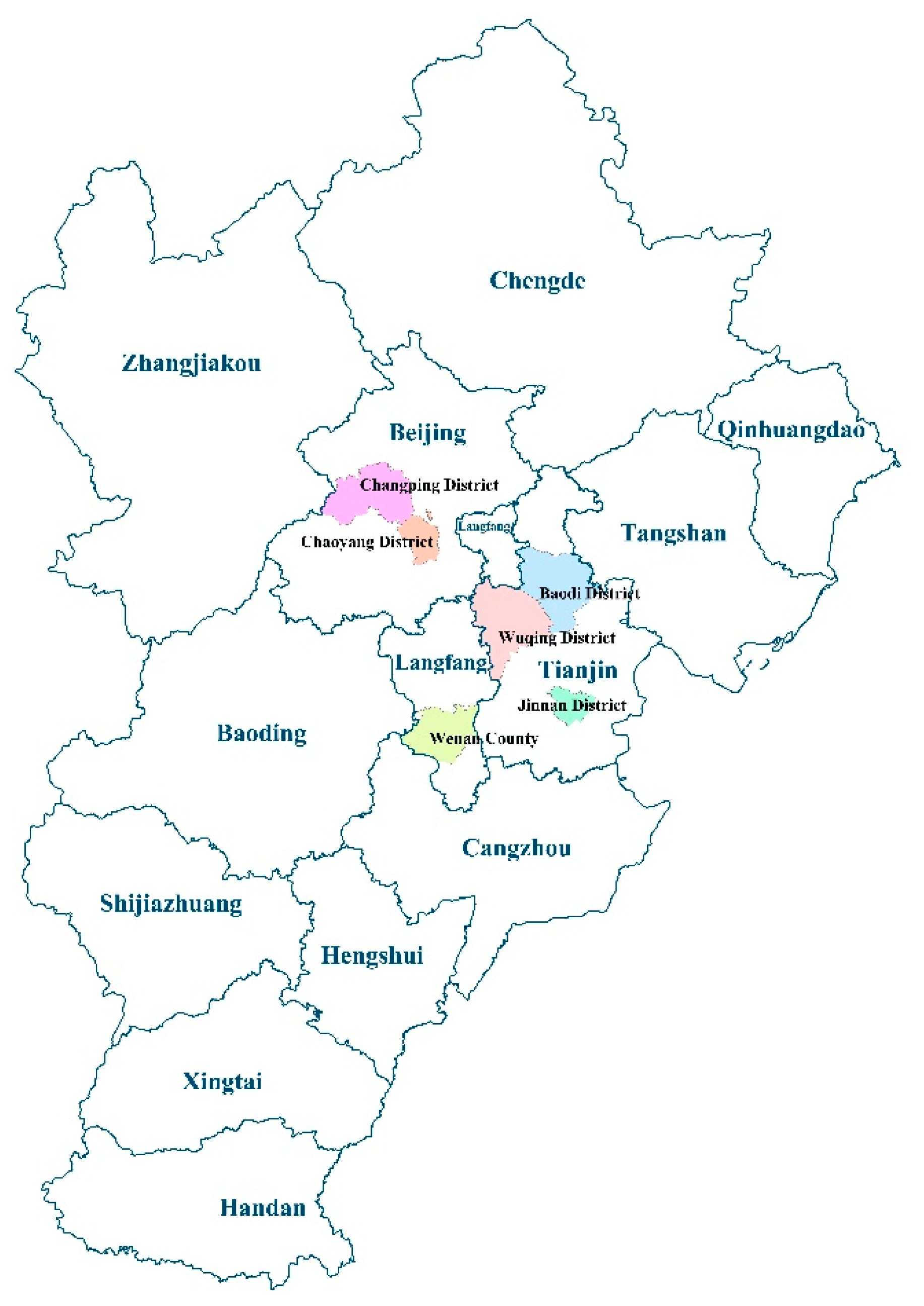
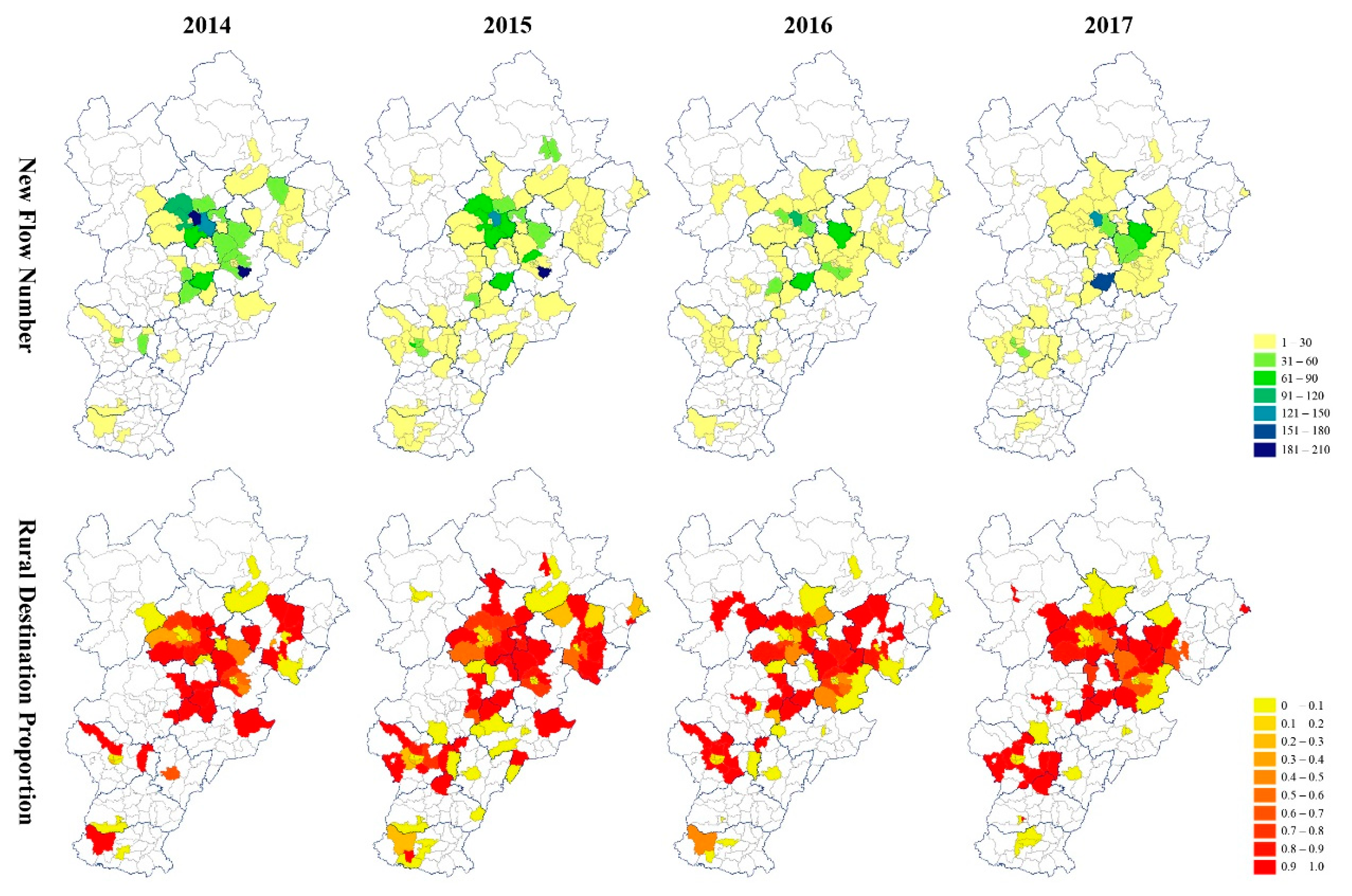
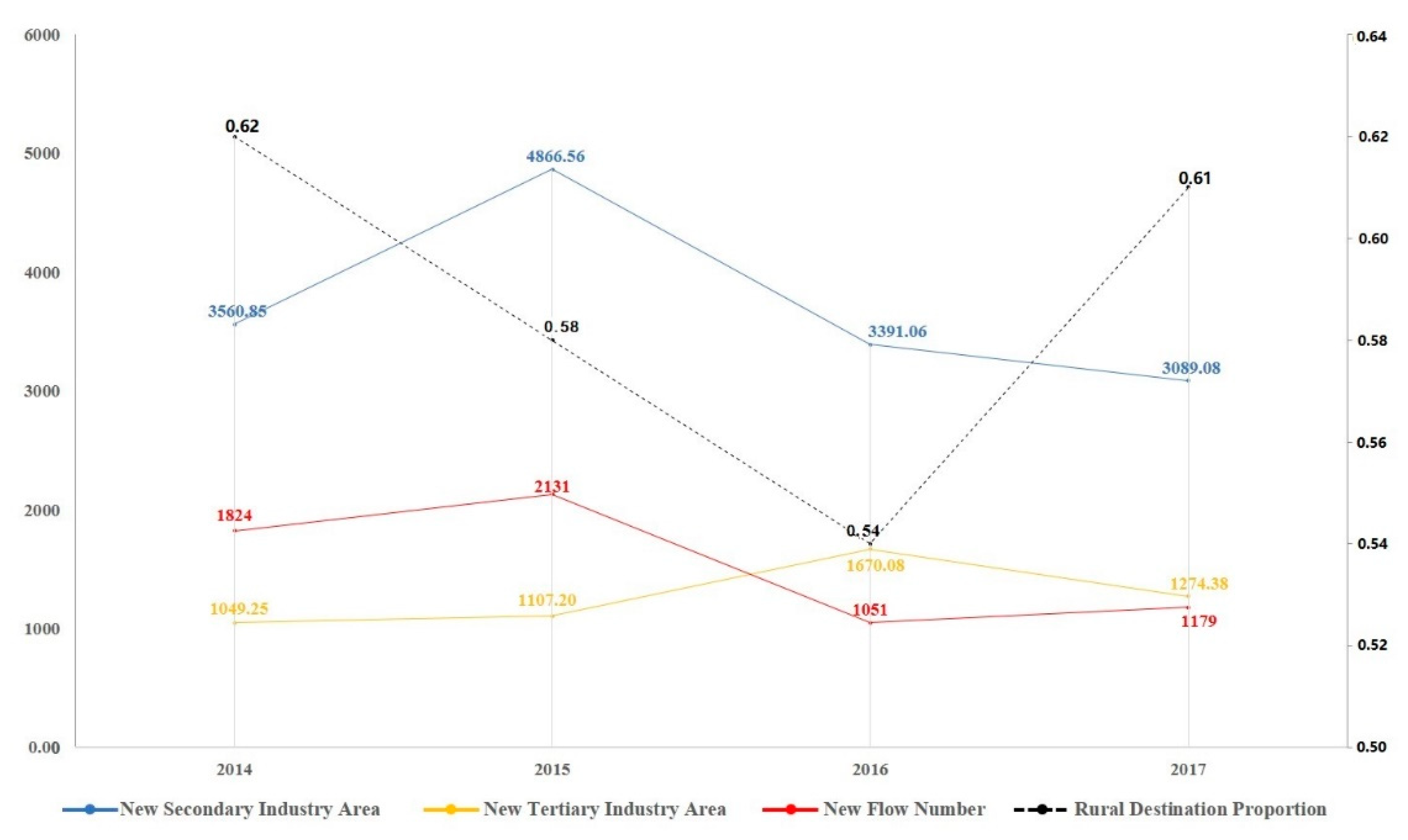
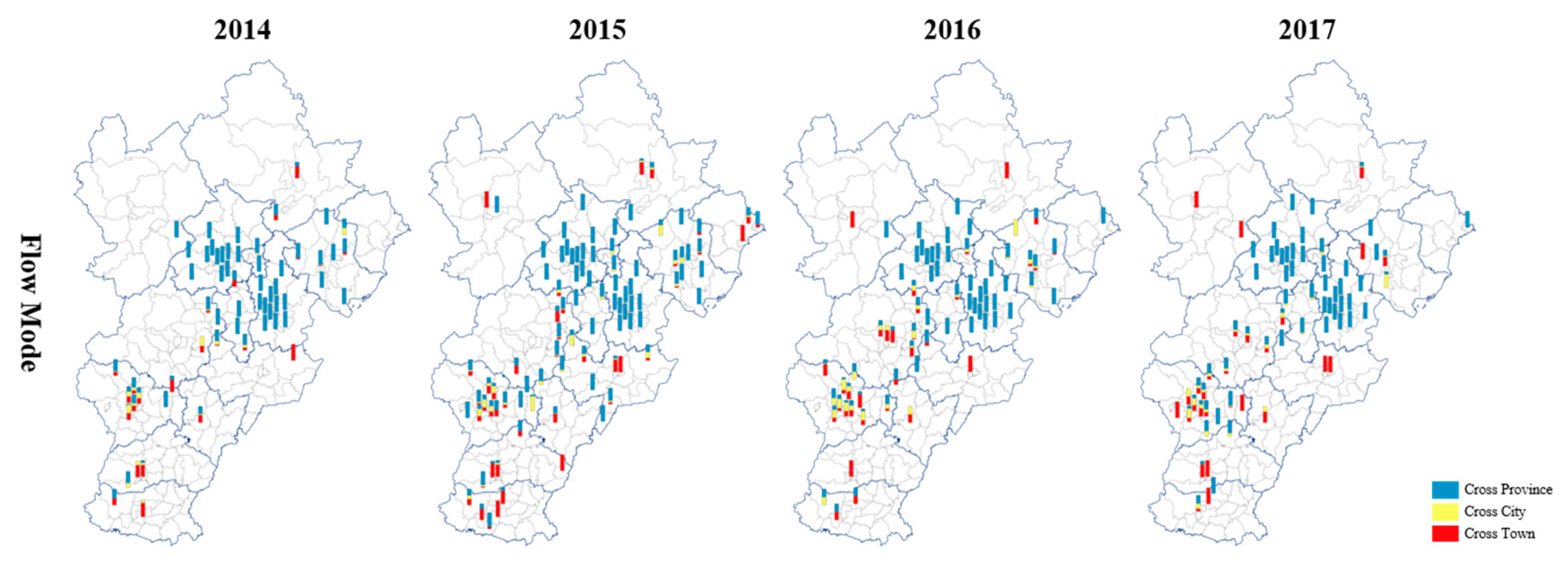
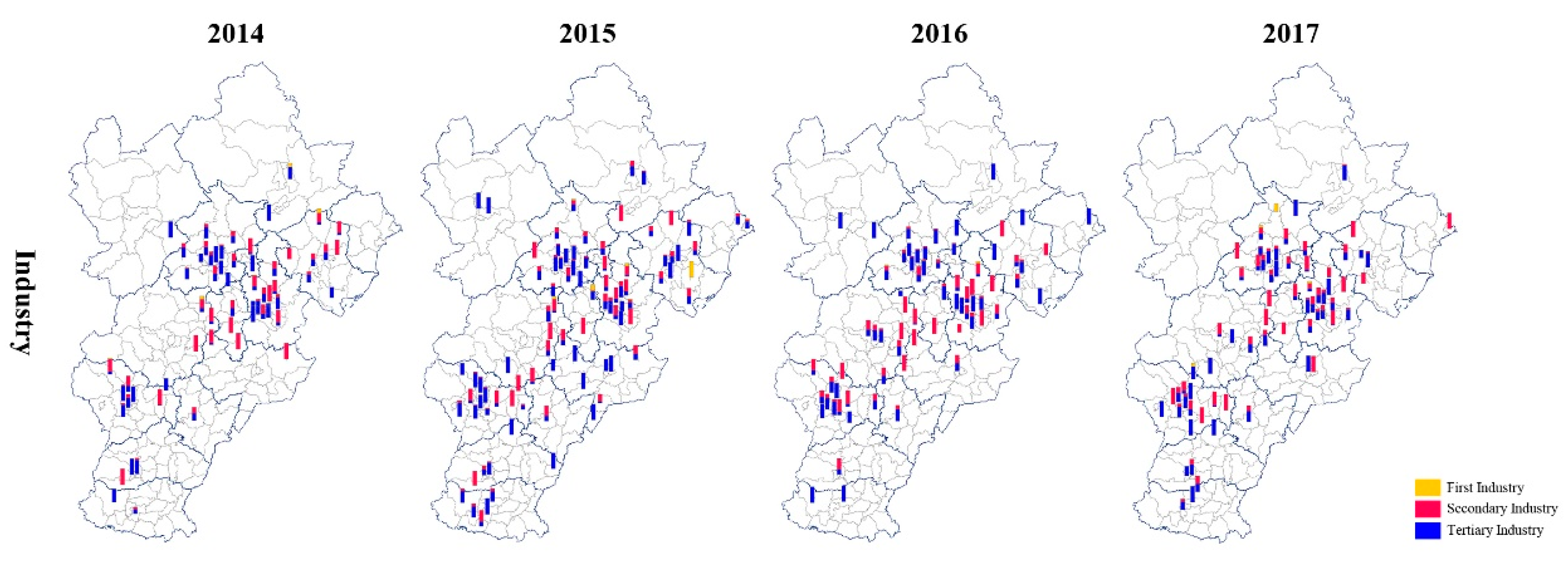
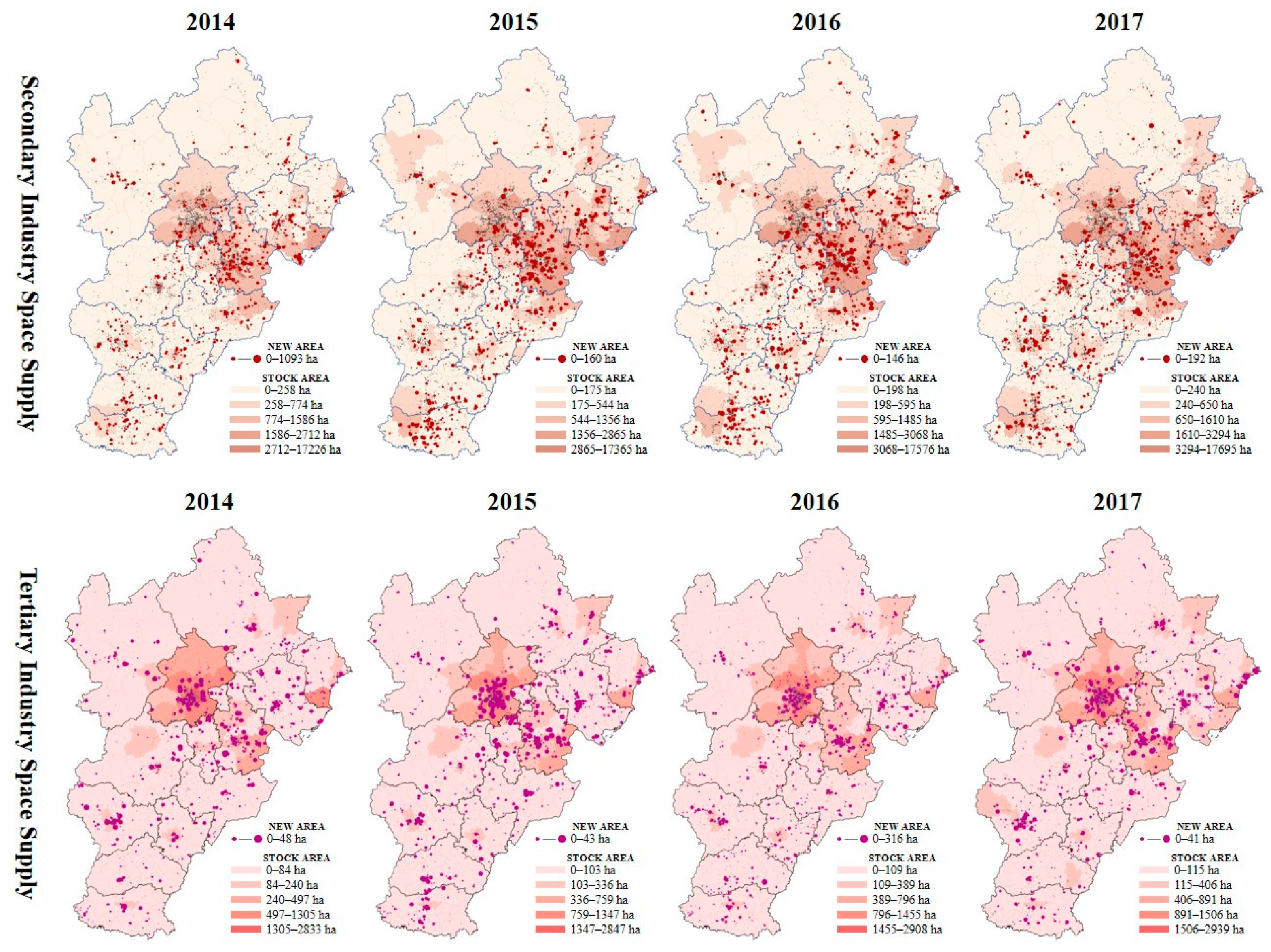
| Indicators | Whether Used in FEM | Abbreviation | |
|---|---|---|---|
| Composition | New Flow Number | √ | NFN |
| Rural Destination Proportion | √ | RDP | |
| Agricultural Residence Registration Proportion | √ | ARRP | |
| Average Age | |||
| Education Level | Under Highschool Proportion | √ | UHP |
| Graduates Proportion | |||
| Post-graduates Proportion | √ | PP | |
| Flow Mode and Aim | Cross Province Proportion | √ | CPP * |
| Cross City Proportion | |||
| Cross Town Proportion | |||
| Job and Business Proportion | |||
| Occupation | the Primary Industry Proportion | √ | FIP |
| the Secondary Industry Proportion | |||
| the Tertiary Industry Proportion | √ | TIP | |
| Government and State-owned Enterprise Proportion | √ | GSEP | |
| Individual Businesses Proportion | √ | IBP | |
| Enterprise Proportion | √ | EP | |
| Other Occupation Proportion | √ | OOP | |
| No Occupation Proportion | √ | NOP | |
| Space Supply | New Number of the Secondary Industry Land Supply | ||
| New Area of the Secondary Industry Land Supply | √ | NA_SILS | |
| Average Lower Limit of New Secondary Industry Land FAR | √ | ALLFAR_SIL | |
| Average Upper Limit of New Secondary Industry Land FAR | √ | AULFAR_SIL | |
| New Number of The Tertiary Industry Land Supply | |||
| New Area of The Tertiary Industry Land Supply | √ | NA_TILS | |
| Average Lower Limit of New The Tertiary Industry Land FAR | √ | ALLFAR_TIL | |
| Average Upper Limit of New The Tertiary Industry Land FAR | √ | AULFAR_TIL | |
| Overall Number of The Secondary Industry Land Supply | |||
| Overall Area of The Secondary Industry Land Supply | |||
| Overall Number of The Tertiary Industry Land Supply | |||
| Overall Area of The Tertiary Industry Land Supply | √ | OA_TILS |
| Rural Destination Proportion (R2 = 0.68) | New Flow Number (R2 = 0.76) | |||||
|---|---|---|---|---|---|---|
| Coefficients | Sig. | Coefficients | Sig. | |||
| (Constant) | 0.003 | 0.870 | (Constant) | 0.002 | 0.976 | |
| Composition | NFN | 0.019 | 0.369 | NFN *** | 0.536 | 0.000 |
| RDP *** | 0.550 | 0.000 | RDP | 0.166 | 0.569 | |
| ARRP ** | −0.282 | 0.031 | ARRP | −0.764 | 0.123 | |
| Education Level | UHP | 0.175 | 0.266 | UHP | 0.255 | 0.670 |
| PP | −0.354 | 0.759 | PP | 2.634 | 0.549 | |
| Flow Mode | CPP * | 0.183 | 0.055 | CPP | 0.233 | 0.520 |
| Occupation | FIP | −0.422 | 0.304 | FIP | 0.740 | 0.635 |
| TIP | −0.107 | 0.401 | TIP | −0.163 | 0.736 | |
| GSEP | −0.101 | 0.552 | GSEP | −0.244 | 0.706 | |
| IBP | 0.271 | 0.129 | IBP | 0.806 | 0.234 | |
| EP * | 0.242 | 0.090 | EP ** | 1.295 | 0.018 | |
| OOP | 0.373 | 0.148 | OOP * | 1.681 | 0.087 | |
| NOP | 0.072 | 0.752 | NOP | 1.239 | 0.157 | |
| Space Supply | NA_SILS | 0.002 | 0.872 | NA_SILS | −0.040 | 0.479 |
| ALLFAR_SIL * | 0.152 | 0.064 | ALLFAR_SIL | 0.295 | 0.342 | |
| AULFAR_SIL | 0.002 | 0.962 | AULFAR_SIL | 0.255 | 0.134 | |
| NA_TILS ** | 0.047 | 0.042 | NA_TILS | −0.067 | 0.440 | |
| ALLFAR_TIL | −0.026 | 0.652 | ALLFAR_TIL *** | −0.680 | 0.003 | |
| AULFAR_TIL | −0.032 | 0.217 | AULFAR_TIL ** | 0.200 | 0.047 | |
| OA_TILS * | −0.035 | 0.075 | OA_TILS * | 0.124 | 0.094 | |
Publisher’s Note: MDPI stays neutral with regard to jurisdictional claims in published maps and institutional affiliations. |
© 2021 by the authors. Licensee MDPI, Basel, Switzerland. This article is an open access article distributed under the terms and conditions of the Creative Commons Attribution (CC BY) license (https://creativecommons.org/licenses/by/4.0/).
Share and Cite
Chen, Y.; Sun, Z.; Cai, L. Population Flow Mechanism Study of Beijing-Tianjin-Hebei Urban Agglomeration from Industrial Space Supply Perspective. Sustainability 2021, 13, 9949. https://doi.org/10.3390/su13179949
Chen Y, Sun Z, Cai L. Population Flow Mechanism Study of Beijing-Tianjin-Hebei Urban Agglomeration from Industrial Space Supply Perspective. Sustainability. 2021; 13(17):9949. https://doi.org/10.3390/su13179949
Chicago/Turabian StyleChen, Yuqi, Zongyao Sun, and Liangwa Cai. 2021. "Population Flow Mechanism Study of Beijing-Tianjin-Hebei Urban Agglomeration from Industrial Space Supply Perspective" Sustainability 13, no. 17: 9949. https://doi.org/10.3390/su13179949
APA StyleChen, Y., Sun, Z., & Cai, L. (2021). Population Flow Mechanism Study of Beijing-Tianjin-Hebei Urban Agglomeration from Industrial Space Supply Perspective. Sustainability, 13(17), 9949. https://doi.org/10.3390/su13179949






